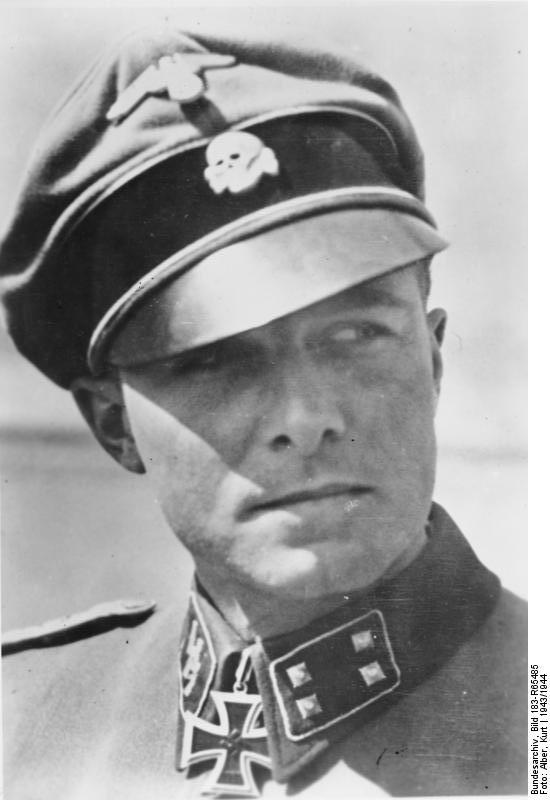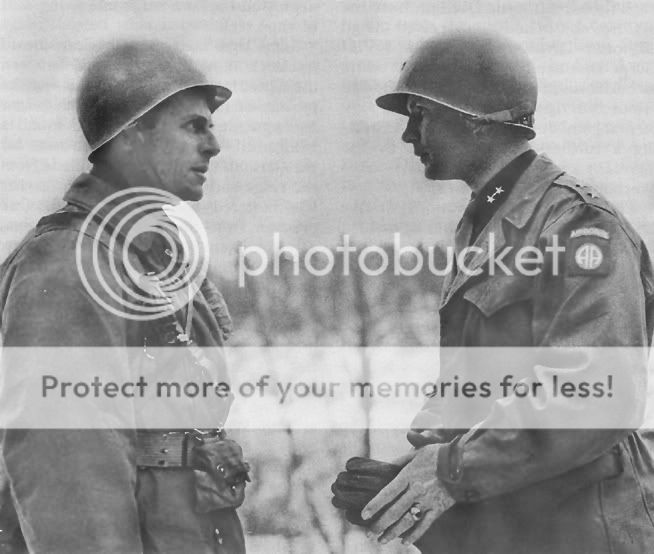Xenophon
Gone and forgotten
The battle of the Bulge opened this day in 1944, in the early morning hours of a cold and misty day. It would be Hitler's final attempt to change the fortunes of war in the west, and it would end in failure at the hands of American arms and american resolve to stand and fight.
The opening of the attack
The Ardennes offensive of December 1944 was the last occasion in which Hitler proved that he was right and his generals wrong. His Wacht am Rhein (Watch on the Rhine) plan for splitting the Allied armies before they could reach and cross the Rhine was an audacious gamble fit to rank with Montgomery's 'Market Garden'. Like 'Market Garden', the Ardennes offensive came close to success but was defeated by natural obstacles and a frantically-improvised defence.
The massing of three armies - 6th SS Panzer, 5th Panzer and 7th Panzer, a total of 20 divisions of which seven were armoured - was a masterpiece made possible, only by the belated placing of the Reich on a full war footing. After all the disasters of 1944, 18 new divisions had been sent to the West by 16th December 1944. The idea was to strike through the Ardennes (held only by six resting American divisions) and cross the Meuse. The generals, under Rundstedt, the supreme commander, would have been content to destroy the 25 Allied divisions east of the Meuse. Hitler, however, insisted on a grandiose drive north-west to Antwerp, with the idea of sweeping through the whole of Montgomery's 21st Army Group with the possibility, even, of forcing an evacuation from the coast, as at Dunkirk in 1940. He ignored the fact that every road in the Ardennes was clogged with snow and mud, as they had not been in summer 1940.
The surprise assault over a 40 mile sector on 16th December cracked open but did not annihilate the American front. The full implications of the German attack were not fully realized at first. The bad weather, including fog, in the period before the attack, and the wooded terrain, between them prevented satisfactory air reconnaissance. As the armour rolled heavily but sluggishly through the breaches, two bastions of resistance - at St Vith and Bastogne - stood firm and cut down the How of the advance. North of the breach the Americans unexpectedly held out, blocking 6th SS Panzer Army and trapping its spearhead in the Ambleve valley. But the deep penetration in the centre by 5th Panzer Army between St Vith and Bastogne threatened disaster for the Allies if the latter should fall.
The Allied recovery
The German success in the first three days of the 'Battle of the Bulge' forced a major decision on the Allied High Command. The German penetration threatened to split the 12th Army Group. So Eisenhower agreed to transfer all US forces north of the breakthrough to Montgomery's command while General Omar Bradley co-ordinated US forces to the south. The US 82nd and 101st Airborne Division were brought up to help stem the German momentum, the 101st with units from 10th Armored Division, holding the key centre of Bastogne. Meanwhile Patton promised to attack towards encircled Bastogne on 22nd December - but on the 20th the 2nd Panzer Division, by-passing Bastogne, got across the Ourthe river and was within 23 miles of the Meuse. Foul weather was also preventing the Allied fighters and supply planes from operating.
On the 22nd, crisis day for the Allies, the Americans started to pull out of the St Vith 'horseshoe' and the 2nd Panzer Division began to drive for the Meuse. But on the 23rd the weather cleared. Supplies were dropped into Bastogne and the German columns came under increasing air attack - over 14,000 sorties were flown in three days from 23rd December. Back at the base of the 'Bulge' there was traffic chaos, with the US forces north of the salient holding on to two of the four roads which the Germans had counted on seizing. And the British and Americans were rushing forces into position, first to block and then to counter-attack.
On Christmas Day, 2nd Panzer reached its 'farthest west' only to run out of fuel at Celles, four miles short of the Meuse. Bastogne was relieved the following day and all German attacks were halted, with the generals finally telling Hitler that there was no hope of reaching the Meuse.
The Bastogne fighting reached its peak on 3rd-4th January, 1945 when the last German attacks on town and corridor failed and the US forces took the counter-offensive. On 16th January the forces 'coming from north and south joined up at Houffalize. On 20th January the weather cleared, permitting full-scale Allied air operations:-By 28th January the last vestiges of the 'Bulge' had been eliminated.
The opening of the attack
The Ardennes offensive of December 1944 was the last occasion in which Hitler proved that he was right and his generals wrong. His Wacht am Rhein (Watch on the Rhine) plan for splitting the Allied armies before they could reach and cross the Rhine was an audacious gamble fit to rank with Montgomery's 'Market Garden'. Like 'Market Garden', the Ardennes offensive came close to success but was defeated by natural obstacles and a frantically-improvised defence.
The massing of three armies - 6th SS Panzer, 5th Panzer and 7th Panzer, a total of 20 divisions of which seven were armoured - was a masterpiece made possible, only by the belated placing of the Reich on a full war footing. After all the disasters of 1944, 18 new divisions had been sent to the West by 16th December 1944. The idea was to strike through the Ardennes (held only by six resting American divisions) and cross the Meuse. The generals, under Rundstedt, the supreme commander, would have been content to destroy the 25 Allied divisions east of the Meuse. Hitler, however, insisted on a grandiose drive north-west to Antwerp, with the idea of sweeping through the whole of Montgomery's 21st Army Group with the possibility, even, of forcing an evacuation from the coast, as at Dunkirk in 1940. He ignored the fact that every road in the Ardennes was clogged with snow and mud, as they had not been in summer 1940.
The surprise assault over a 40 mile sector on 16th December cracked open but did not annihilate the American front. The full implications of the German attack were not fully realized at first. The bad weather, including fog, in the period before the attack, and the wooded terrain, between them prevented satisfactory air reconnaissance. As the armour rolled heavily but sluggishly through the breaches, two bastions of resistance - at St Vith and Bastogne - stood firm and cut down the How of the advance. North of the breach the Americans unexpectedly held out, blocking 6th SS Panzer Army and trapping its spearhead in the Ambleve valley. But the deep penetration in the centre by 5th Panzer Army between St Vith and Bastogne threatened disaster for the Allies if the latter should fall.
The Allied recovery
The German success in the first three days of the 'Battle of the Bulge' forced a major decision on the Allied High Command. The German penetration threatened to split the 12th Army Group. So Eisenhower agreed to transfer all US forces north of the breakthrough to Montgomery's command while General Omar Bradley co-ordinated US forces to the south. The US 82nd and 101st Airborne Division were brought up to help stem the German momentum, the 101st with units from 10th Armored Division, holding the key centre of Bastogne. Meanwhile Patton promised to attack towards encircled Bastogne on 22nd December - but on the 20th the 2nd Panzer Division, by-passing Bastogne, got across the Ourthe river and was within 23 miles of the Meuse. Foul weather was also preventing the Allied fighters and supply planes from operating.
On the 22nd, crisis day for the Allies, the Americans started to pull out of the St Vith 'horseshoe' and the 2nd Panzer Division began to drive for the Meuse. But on the 23rd the weather cleared. Supplies were dropped into Bastogne and the German columns came under increasing air attack - over 14,000 sorties were flown in three days from 23rd December. Back at the base of the 'Bulge' there was traffic chaos, with the US forces north of the salient holding on to two of the four roads which the Germans had counted on seizing. And the British and Americans were rushing forces into position, first to block and then to counter-attack.
On Christmas Day, 2nd Panzer reached its 'farthest west' only to run out of fuel at Celles, four miles short of the Meuse. Bastogne was relieved the following day and all German attacks were halted, with the generals finally telling Hitler that there was no hope of reaching the Meuse.
The Bastogne fighting reached its peak on 3rd-4th January, 1945 when the last German attacks on town and corridor failed and the US forces took the counter-offensive. On 16th January the forces 'coming from north and south joined up at Houffalize. On 20th January the weather cleared, permitting full-scale Allied air operations:-By 28th January the last vestiges of the 'Bulge' had been eliminated.










